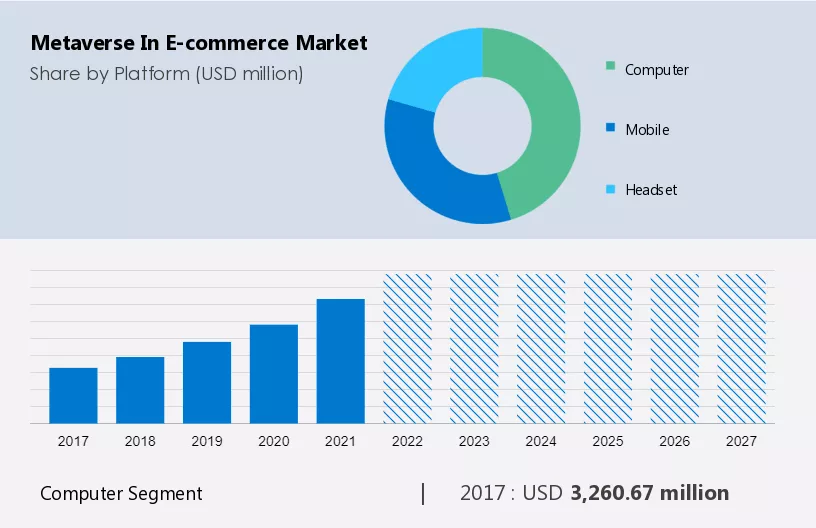Did you know that in 2022, the global metaverse market was valued at over $65 billion? That’s right, the metaverse is not just a buzzword; it’s a rapidly growing digital landscape that’s reshaping how we shop, connect, and explore online.
Imagine stepping into a virtual store, trying on digital sneakers, or even owning unique virtual fashion items. In this article, we’ll dive into the exciting intersection of the metaverse and e-commerce, where immersive customer experiences and innovative shopping adventures await.
So, fasten your seatbelts as we explore the fusion of these digital realms and discover how they’re changing the way we shop in the digital age.
What is the Metaverse?
The metaverse is a digital space that uses various technologies to connect users from around the globe. It’s like a big, interconnected digital world where people can hang out, have fun, work, and even shop using the internet. In this digital universe, you can do a lot of things, just like in the real world. But it’s all happening on your computer or other gadgets. It’s like an immersive version of the internet where everything feels more real and interactive.
Science fiction books like Snow Crash and Ready Player One helped to popularize the concept of the metaverse back in the 1990s. Today, a number of cutting-edge technologies are driving the metaverse concept.
Augmented reality (AR) and virtual reality (VR) play pivotal roles in creating this immersive world. AR overlays digital content in the real world. VR immerses users in an entirely digital world. These technologies have become more accessible with devices like VR headsets and AR-equipped smartphones.
Key platforms driving the metaverse include tech giants such as Meta (formerly Facebook). Meta envisions a metaverse where people can interact, socialize, and work in digital spaces. Roblox is a user-generated online gaming platform. It also contributes to the metaverse by allowing users to create and share experiences.
The Growth of Ecommerce
E-commerce has grown really big in recent years. One big reason is that more and more people are using the internet to shop. Isn’t it convenient to order everything you want right from your smartphone without getting out of bed?
In 2022, the global e-commerce market was worth over $5.5 trillion, and it’s predicted to keep growing. People like e-commerce because it’s convenient. You can shop from home, and your items get delivered to your doorstep.
But because so many people are shopping online, there’s a lot of competition. This means that if you’re running an online store, you need to be creative and use new ideas to stand out.
This is where innovation comes in. Companies need to come up with new and exciting ways to sell products and make the shopping experience better.
For example, some e-stores use smart algorithms to suggest products you might like based on what you’ve bought before. Others use technologies like AR to let you see how products would look in your own home before buying them.
Innovation in e-commerce is important to keep customers happy and to keep up with the growing number of online shoppers. Companies need to come up with fresh ideas. Or they might lose customers to other stores that offer a more exciting shopping experience. So, innovation in e-commerce is a big deal, and it’s the key to staying competitive in this digital age.
Ecommerce and the Metaverse
The intersection of the metaverse and e-commerce is an exciting one. It’s rapidly changing how we shop and do business online. Virtual storefronts are an essential part of this transformation. These are like online shops, but they look and feel more like real physical stores.
People can browse, pick items, and even “try on” products using technologies like AR and VR. 71% of consumers say that they would buy more if AR technology was more available. For e-commerce businesses, this is a game-changer.

They can create new immersive shopping experiences. Customers can see how items fit into their lives before making a purchase. This boosts customer engagement and trust, making it more likely for people to buy. Mobile AR technology’s global market size is projected to reach over US $32 billion by 2023.
AR and VR also enhance the storytelling aspect of e-commerce. These allow businesses to tell their brand stories in more interactive and engaging ways. It gives them the chance to create emotional connections with customers.
IKEA has already introduced an AR app that helps customers visualize how furniture would look in their homes. Virtual showrooms simulate real-world shopping environments. These spaces let shoppers explore products in a more immersive way and are rapidly becoming popular.
As the metaverse continues to shape e-commerce, we see companies adapting to these technologies to provide a richer online shopping experience. It’s evident that these changes are here to stay.
E-commerce is transforming into a more interactive and engaging space for shoppers. This makes shopping not just convenient but also a lot more fun.
Enhanced Customer Engagement
The metaverse offers some super-cool experiences for customers. These are totally different from regular online shopping. It’s like going on a fun adventure when you shop.
One cool concept is virtual showrooms. Instead of just looking at pictures of products, you can step into a digital store that feels like a real one. You can walk around, pick up items, and even try them out using virtual reality or augmented reality.
For example, car companies create virtual showrooms where you can sit in the driver’s seat and see how it feels. You can do all this without actually going to a physical dealership.
Another neat use case is the “try before you buy” idea. In the metaverse, you can use your gadgets to see how products would fit into your life before you buy them. Like trying on clothes virtually or seeing how furniture looks in your home without lifting anything heavy. This makes shopping more fun and less risky because you know what you’re getting.
Some companies are already using the metaverse to make shopping awesome. Brands like Nike are selling virtual sneakers that you can wear in the metaverse and even show off to your friends.
The metaverse makes shopping an adventure. These companies are using it to engage customers in a whole new way, making shopping more fun and interactive.
What are the Benefits?
Integrating e-commerce with the metaverse offers a myriad of advantages. It enhances the customer experience by making it more immersive and engaging. Customers can step into virtual stores, try out products using augmented reality, and even interact with other shoppers. This creates a dynamic shopping environment. It’s much more enjoyable than traditional two-dimensional online stores.

The metaverse allows businesses to tell their brand stories in a more engaging way. They can create emotional connections with customers this way. It adds a social element to shopping, where friends and family can shop together. They can get recommendations from others. This replicates the real-world shopping experience.
The metaverse introduces innovative opportunities for businesses to showcase and sell their products. Virtual storefronts can be highly effective for companies. Fashion brands can offer virtual dressing rooms where customers can see how clothes fit on them before deciding.
This reduces the uncertainty associated with online shopping and increases customer confidence. Ultimately, it leads to higher conversion rates. The metaverse can open new revenue streams. Businesses can host virtual events and launch new products, allowing for more sales and brand exposure.
Integrating e-commerce with the metaverse has the potential to reach a global audience. Shoppers from around the globe can visit virtual stores and engage with products. This helps break down geographical barriers.
This can be particularly beneficial for small and niche businesses looking to expand their reach. It offers a more sustainable shopping option, as it reduces the need for physical stores and the associated carbon footprint. With the metaverse’s environmentally friendly approach, businesses can contribute to a greener future.
Gucci Garden
A notable example of a brand effectively utilizing the metaverse for e-commerce is the luxury fashion house Gucci. It has ventured into the metaverse to create unique shopping experiences for its customers.
In May 2021, Gucci partnered with Roblox to launch a virtual world called Gucci Garden. Users can stroll through a virtual garden modeled after Gucci’s actual locations.
They could try on and purchase digital Gucci items for their avatars, similar to how one would shop for physical clothing. This innovative approach allowed Gucci to tap into the growing market for digital fashion and accessories. And it appealed to the Roblox community’s creative and fashion-conscious user base.
Gucci’s venture into the metaverse showed how luxury brands can use virtual platforms to reach new audiences and experiment with novel marketing strategies. It showcased the potential of the metaverse as an extension of the traditional e-commerce experience. It’s also a space for creative and interactive engagement with customers.
CryptoKicks
In 2021, Nike launched its first virtual sneakers, known as CryptoKicks. These digital shoes are part of the company’s experiment with NFTs and blockchain technology. Each pair of CryptoKicks is a unique digital asset that users can buy, own, and trade.
These digital sneakers are stored on the blockchain and user avatars can wear them in the metaverse. They represent a new way for Nike to connect with its audience and cater to the emerging trend of digital fashion and collectibles.
This innovative approach allows Nike to not only explore the metaverse but also experiment with the concepts of digital scarcity and ownership. It’s a prime example of how a traditional brand can adapt to the changing digital landscape.
Nike’s move into the metaverse shows that even industries as established as sportswear can find value in exploring digital realms. It gives them the chance to stay at the forefront of emerging trends in e-commerce and digital engagement.
Major Challenges to Address
Integrating the metaverse into e-commerce brings lots of excitement. But there are also some aspects to be careful about. These concerns include data privacy, security, and accessibility. These need to be carefully addressed to ensure a safe and inclusive shopping experience.
Data Privacy
One significant concern is the privacy of our personal data. In the metaverse, we share information about ourselves, such as our behaviors, preferences, and interactions. It’s crucial for companies to handle this data responsibly and securely.
We must have control over what we share and with whom. Stores should be transparent about how they use our data. They must follow strict privacy regulations to protect our personal information.
Security
Just as in the physical world, there are potential risks in the metaverse. Cybercriminals may try to exploit the digital environment for malicious purposes. They can steal information or cause harm.
Ecommerce companies must put in place robust security measures, such as encryption and user authentication. These will help protect their virtual stores and their customers from digital threats. Maintaining a safe metaverse is essential to building trust and ensuring a secure shopping experience.
Accessibility
Accessibility is another critical concern. The metaverse relies on technology, which may not be accessible to everyone. It’s essential that companies consider the needs of everyone. An important audience here is people with disabilities.
Companies must ensure that the metaverse is designed to accommodate them. This includes features like screen readers for the visually impaired, easy navigation for those with mobility challenges, and inclusive design for a wide range of users. Accessibility ensures that everyone can enjoy the metaverse without limitations.
Metaverse: Shopping’s Digital Revolution
The metaverse and e-commerce are joining forces to transform how we shop and connect online. This exciting partnership brings interactive experiences, making shopping more fun and personal.
Brands like Gucci and Nike are leading the way by venturing into these digital worlds to engage with customers and create unique shopping adventures.
But, as we journey into this new digital frontier, we must also be mindful of concerns like data privacy and security. Ensuring a safe and inclusive metaverse experience is essential. The metaverse is redefining the way we shop. As it continues to evolve, it promises exciting possibilities and opens new doors in the digital age.
Have you used the metaverse to shop? Let us know in the comments below!

















